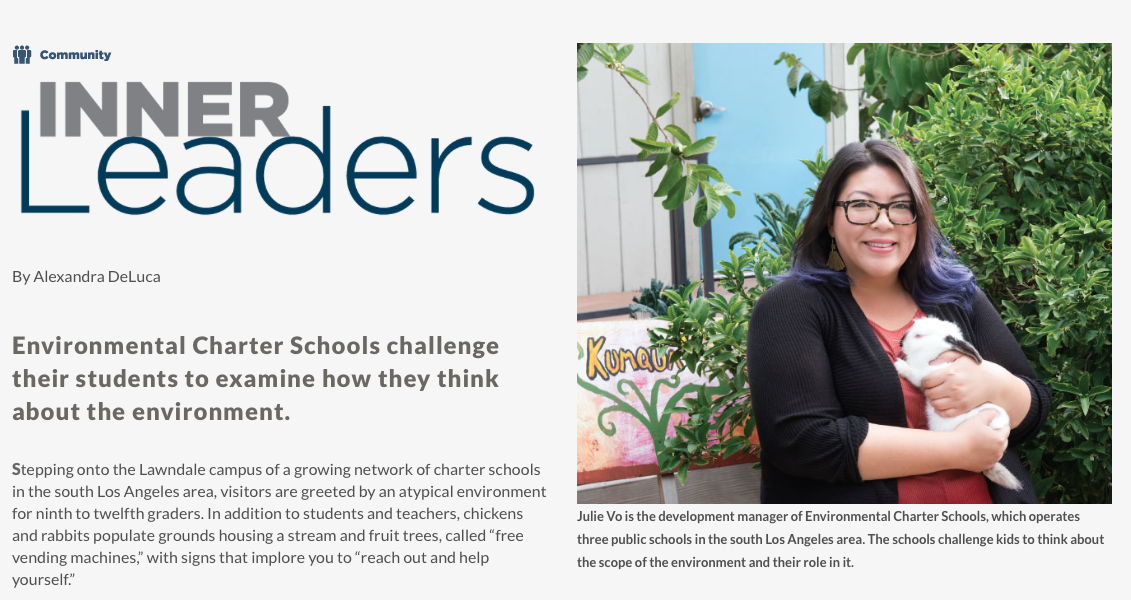By Alexandra DeLuca
Environmental Charter Schools challenge their students to examine how they think about the environment.
Stepping onto the Lawndale campus of a growing network of charter schools in the south Los Angeles area, visitors are greeted by an atypical environment for ninth to twelfth graders. In addition to students and teachers, chickens and rabbits populate grounds housing a stream and fruit trees, called “free vending machines,” with signs that implore you to “reach out and help yourself.”
“We often tell people that you really have to come and see it for yourself,” says Julie Vo, development manager of Environmental Charter Schools (ECS), which was established in 2000 and now operates three free public schools with more than 1,000 students. “I can send photos and compose lengthy emails, but it’s stepping onto our campuses that really gives you a feel of our campus culture.”
That culture, tucked in the shadows of some of the nation’s busiest highways, focuses on interdisciplinary and real-world learning, says Vo, while leveraging community partners like the U.S. Green Building Council (USGBC) to elevate and improve students’ experiences. The school won a 2016 “Best of Green Schools” award in the category for K–12 schools from USGBC’s Center for Green Schools.
Like the lush fruits, vegetables, and plants, which extend beyond the campus to the surrounding community to include more than 100 organic offerings, Vo says ECS challenges its students to examine their own thinking about the scope of the environment. “In a traditional sense, this means a focus on environmental sustainability—waste, water, food, and energy. We ask our students how this applies to the school as well as to their communities, and we challenge them to think about the role they play in effecting positive change.”

The curriculum is a reflection of that. For example, during the last annual intersession—the four weeks between winter and the start of the next semester—students tackled projects that focused on big picture ideas, ranging from the definition of the “American dream” to sustainability, education, quality of life, food and job security, and health. This approach led to student research on more specific topics such as food deserts, the tiny homes movement, and gentrification.
“That is very much a central theme,” she says. “Make it personal. The things they are learning in the classroom are applicable to their everyday lives and their own communities.”

All students at ECS take a required Green Ambassadors course. This past year, tenth graders at Environmental Charter High School (ECHS) focused on food justice and food access. The students organized the People’s Food, a culminating tasting event on campus for the community featuring local, sustainable foods. Green Ambassadors students also collaborated with local nonprofit GrowingGreat to learn more about the issue. In past years, students also studied water conservation and preservation and hosted a water symposium with community experts and partners including Surfrider Foundation, West Basin Municipal Water District, and Heal the Bay. Students were responsible for managing all aspects of the event, from the detailed day-of logistics to creating social media buzz and marketing the event. “At ECS, we empower our students to become community ambassadors,” Vo says.
Beyond that, students can participate in the Green Ambassadors Internship, which allows them to connect with the larger community. Most recently, students—clipboards in hand—worked with local business owners to perform energy audits. They took the data they collected, analyzed it, and came back with a formal presentation to executives with actionable recommendations. “Our students encouraged the company leadership to consider their company culture and what it really means to be green,” says Vo. In addition, students are gaining real-world experience. “They understand that this work they are doing now could potentially become a career track,” says Vo.
ECS is a college preparatory school. “From the moment they step foot on the campus, it is not if but where they are going to college,” she says. It is a requirement for graduation and one that 98 percent of the graduating class achieves to complete the coursework necessary to get admitted to a four-year university. In this year’s class, 97 percent were admitted to a four-year institution compared with 35 percent statewide. An impressive statistic coupled with the fact that 63 percent are first generation college students; additionally, 91 percent of the three-school student body qualifies for free or reduced lunch.
In the past six years, the school has expanded quickly from one to three schools, and the current focus is on best practices and ensuring that facilities and operations are running in top shape, says Vo. “We are looking at the possibility of growing in coming years. We want to create green campuses that are student centered and thriving learning spaces for our students and their families.”
“Outdoor education is also an integral part of our ECS best practices. As an environmental charter school, it is crucial that our students have access to outdoor space and outdoor experiences,” Vo says.
In what may be the first time camping for many, all ECS students participate in outdoor overnight camping or backpacking trips. These trips often “push and challenge students,” says Vo, and sometimes in unexpected ways.

“Not every student comes to ECS because they are crazy passionate about the environment, but once they are here, they are exposed to new experiences that build and strengthen their community, and they achieve things personally they didn’t think they could,” she adds.
In addition to outdoor education, students work on the Pacific Crest Trail (PCT) several times a year, performing trail work like maintenance and cleaning. The Pacific Crest Trail Association (PCTA) has also invited students to travel to Washington, D.C., with the organization to advocate for more green space and access to public land for communities of color.
“Our students have been on the Hill, sharing their experiences on the trail and their testimonies,” Vo says. “They have honed their public speaking skills and are confident enough to share their own experiences and what really matters to their communities and families.”
Vo, who has been with ECS for more than a year, has an especially distinct perspective, having attended a larger high school down the road. “I really believe in the mission of ECS, having grown up in this area. I understand not having access to these types of experiences we are able to offer—experiences that wouldn’t be available if they went to a larger school.”
“We always say that our students are our superheroes,” she adds. “Many believe that they are the future leaders of our community, but our philosophy is that they are the leaders now. It’s not about waiting until later on to identify their inner leader. They are the present leaders, and they have the skills and capacity to bring the change we want to see now. And we are giving them a platform and tools they need to make that happen.”
Next Generation of Green Ambassadors
A 2014 study of job postings across the U.S. indicated that demand for LEED Green Associates and LEED APs had grown 46 percent over the prior 12 months. In addition, a 12-month scan of U.S. job listings found more than 9,000 available jobs that specifically require a LEED credential.
With this in mind, USGBC and ECS have teamed up on a pilot program this summer to test drive a new pathway to LEED certification while becoming more desirable to college and job applicants in the process.
This past August, Rachel Gutter, USGBC senior vice president of Knowledge and director of the Center for Green Schools, led a group of Los Angeles high school students through a LEED Green Associate exam prep course and included a field trip to a current construction project. Silver Star Apartments, which will be a homeless shelter for veterans, is aiming for LEED Platinum and net-zero energy.
“In addition to visits from leading sustainability professionals in a variety of disciplines—from green builders to consultants—a visit to the construction site was one of the best ways to understand these concepts in real time,” says Gutter.
ATP donated the study materials for the students and Cuningham Group paid for the exams. After passing the exam, ECS students will be among some of the first people under the age of 18 to become LEED credentialed and will attend the Greenbuild International Conference and Expo this fall, which is also in LA.
“So much of the work that we are in the position of doing in education is about servicing the complete life cycle of a learner,” says Gutter, “but more than anything, we are excited to introduce our USGBC community at Greenbuild to what the new generation of leadership looks like in sustainability.
“We called them sustainability natives—fluent in green, where sustainable ideas are baked into their mindset and intuitively drives their decisions. It is their true north,” she adds.
CLICK for source article.







